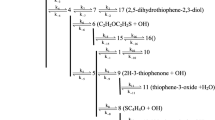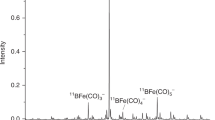Abstract
IN spite of the importance of information about molecular complex formation in the gas phase, almost all the published reports on charge–transfer complexes have dealt with condensed phases. Because of the low volatility of most charge–transfer complexes and problems connected with obtaining the spectra of gas mixtures of accurately known concentration, it is difficult to determine reliable values of the complex formation constants (Kc) and extincion coefficients (ε). Recent studies have yielded some spectral and thermodynamic data for complexes of iodine1,2, tetracyanoethylene3 and carbonyl cyanide4,5 with several donors. From the results that have been published, it appears that in the case of weak complexes ε is considerably smaller and Kc much larger in gas than in solution, assuming simple 1 : 1 interaction of the components. For moderately strong complexes, solvation effects are less important, but the transfer from gas to solvent still induces a decrease in Kc and an increase in ε. The results reported by Burg in 1943 (ref. 6), including dissociation pressures of the solid compound (CH3)3N·SO2 and vapour densities of mixtures of sulphur dioxide and trimethylamine, provide indirect evidence that a molecular complex between these components is present in measurable concentrations in the gas phase. We have now obtained a number of spectral and thermodynamic parameters for the trimethylamine–sulphur dioxide complex, both in the gas phase (15°–60° C) and in heptane (13°–40° C). In a series of sixteen separate experiments at 39.7° C, the peak absorbance of the complex varied from 0.10 to 0.60 in an 8 cm gas cell, at amine concentrations in the range 0.4 × 10−3 to 4.9 × 10−3 moles/l, and sulphur dioxide concentrations from 2.3 × 10−5 to 5.9 × 10−5 moles/l. The percentage of acceptor molecules complexed varied from 5 to 45 under these conditions, making it possible to determine precise values of Kc and ε. From the variation of absorbance with temperature at various concentrations of the components, it was possible to obtain both ΔH0 for the gas phase complex formation reaction and the enthalpy (ΔHs) for the reaction (CH3)3N·SO2 (solid) = (CH3)3N·SO2 (gas). The latter constant was deduced from the temperature dependence of the complex absorbance in the gas phase measured with the solid complex in the cell under an excess pressure of the amine. To our knowledge this is the first time a sublimation energy has been reported for a charge–transfer complex. Table 1 summarizes parameters obtained for the complex and for the formation reaction. Included are approximate values of ΔH0 and Kc which we have estimated from the vapour density data of Burg and the enthalpy (ΔHd) for the reaction (CH3)3N·SO2 (solid) = (CH3)3N (gas) + SO2 (gas) calculated from his dissociation pressures. The sum of ΔHS and −ΔH0 from the present results (27.4 kcal) is in reasonable agreement with the value of ΔHd (28.9 kcal) calculated from Burg's results.
This is a preview of subscription content, access via your institution
Access options
Subscribe to this journal
Receive 51 print issues and online access
$199.00 per year
only $3.90 per issue
Buy this article
- Purchase on Springer Link
- Instant access to full article PDF
Prices may be subject to local taxes which are calculated during checkout
Similar content being viewed by others
References
Lang, F. T., and Strong, R. L., J. Amer. Chem. Soc., 87, 2345 (1965).
Goodenow, J. M., and Tamres, M., J. Chem. Phys., 43, 3393 (1965).
Kroll, M., and Ginter, M. L., J. Phys. Chem., 69, 3671 (1965).
Prochorow, J., J. Chem. Phys., 43, 3394 (1965).
Prochorow, J., and Tramer, A., J. Chem. Phys., 44, 4545 (1966).
Burg, A. B., J. Amer. Chem. Soc., 65, 1629 (1943).
Briegleb, G., Elektronen-Donator-Acceptor-Komplexe (Springer Verlag, Berlin, 1961).
Author information
Authors and Affiliations
Rights and permissions
About this article
Cite this article
CHRISTIAN, S., GRUNDNES, J. Charge-Transfer Complex between Sulphur Dioxide and Trimethylamine in the Gas Phase and in Heptane. Nature 214, 1111–1112 (1967). https://doi.org/10.1038/2141111b0
Received:
Issue Date:
DOI: https://doi.org/10.1038/2141111b0
This article is cited by
-
Surface treatment of poly(3-pentylthiophene) by ionizing radiation
Journal of Radioanalytical and Nuclear Chemistry Letters (1992)
Comments
By submitting a comment you agree to abide by our Terms and Community Guidelines. If you find something abusive or that does not comply with our terms or guidelines please flag it as inappropriate.



